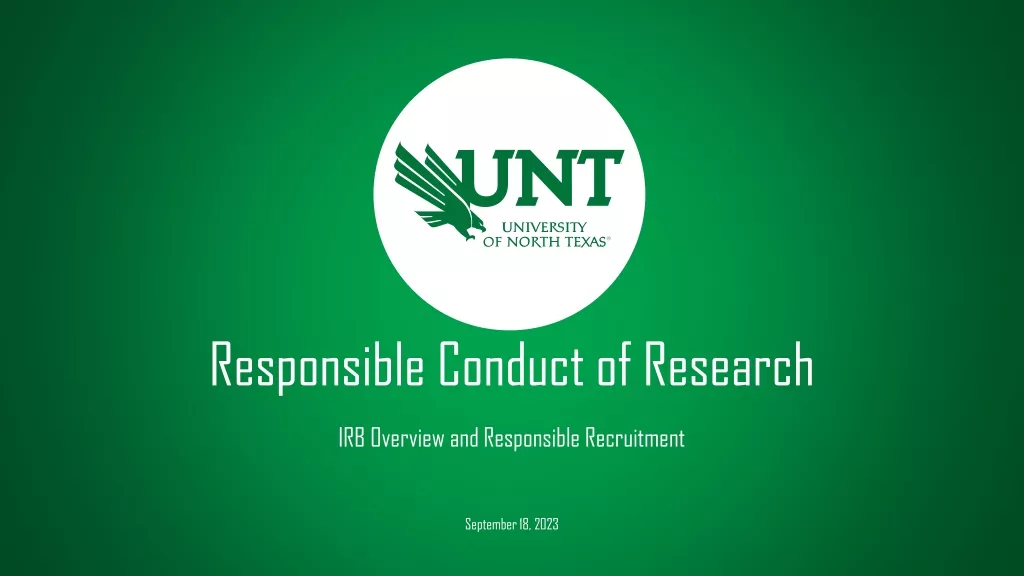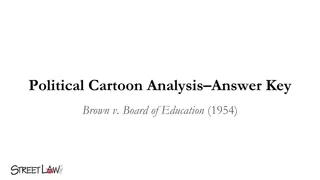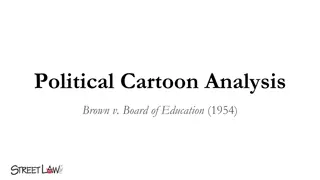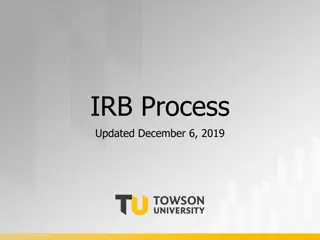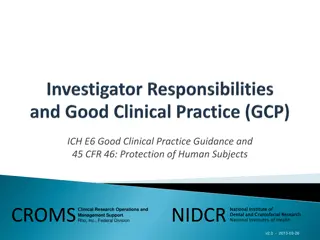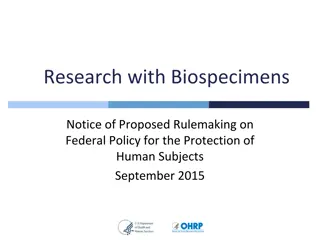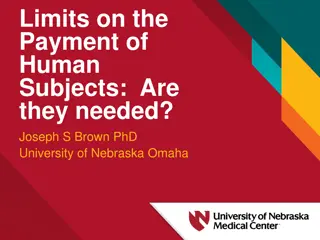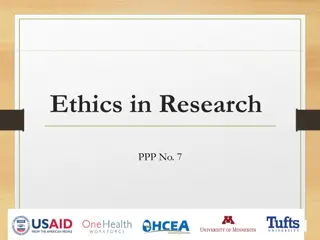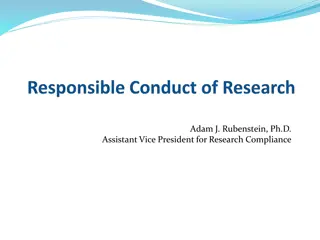
Research with Human Subjects - Key Principles and Regulations
Explore the ethical principles, regulations, and classifications of research involving human subjects as outlined by the Office of Research Integrity. Learn about the definition of research, different types of investigations, and activities not considered research. Gain insights into the responsibilities associated with human subject research.
Download Presentation

Please find below an Image/Link to download the presentation.
The content on the website is provided AS IS for your information and personal use only. It may not be sold, licensed, or shared on other websites without obtaining consent from the author. If you encounter any issues during the download, it is possible that the publisher has removed the file from their server.
You are allowed to download the files provided on this website for personal or commercial use, subject to the condition that they are used lawfully. All files are the property of their respective owners.
The content on the website is provided AS IS for your information and personal use only. It may not be sold, licensed, or shared on other websites without obtaining consent from the author.
E N D
Presentation Transcript
Humans as Subjects Information for this module came from the Office of Research Integrity (ORI) website: https://ori.hhs.gov/content/chapter-3- The-Protection-of-Human-Subjects-introduction (additional information by Nicholas Steneck, PhD)
Overview Research with human subjects can provide benefits to society as a whole as well as the subjects themselves whether medical (drug or device) research or social science research. This presentation will help you better understand your responsibilities related to human subject research. 2
Objectives Participants will be able to describe the: Three ethical principles and their application to research with humans Basic regulations related to research with humans Different classifications of research 3
What is research? As defined in the Code of Federal Regulations, research is: A systematic investigation, including research development, testing and evaluation, designed to develop or contribute to generalizable knowledge 45 CFR 46.102(l) 4
What is research (clinical investigation)? As defined in the Code of Federal Regulations, clinical investigation is: Any experiment that involves a test article and one or more human subjects and that is subject to requirements for prior submission to the Food and Drug Administration (FDA) 21 CFR 50.3(c) 5
There are many activities that are not considered research: Quality improvement Case Studies (up to 3 clinical cases) Program evaluation Classroom or coursework Oral history Public health surveillance activities Collection and analysis of information, biospecimens, or records by or for a criminal justice agency for activities authorized by law or court order solely for criminal justice or criminal investigative purposes. 6
What is a human subject? A living individual about whom an investigator (whether professional or student) conducting research: (1) Obtains data/information or biospecimens through intervention or interaction with the individual, and uses, studies, or analyzes the information or biospecimens, or (2) Obtains, uses, studies, analyzes, or generates identifiable private information or identifiable biospecimens 45 CFR 46.102(F) 7
What is the Belmont Report? The Belmont Report was written by the National Commission for the Protection of Human Subjects of Biomedical and Behavioral Research. The Commission, created as a result of the National Research Act of 1974, was charged with identifying the basic ethical principles that should underlie the conduct of biomedical and behavioral research involving human subjects and developing guidelines to assure that such research is conducted in accordance with those principles. DHHS 8
What are the ethical principles from the Belmont Report? (1) - Respect for Persons: individuals should be treated as autonomous agents and able to make decisions Persons with diminished autonomy are entitled to protection DHHS 9
What are the ethical principles from the Belmont Report? (2) - Beneficence: persons are treated in an ethical manner by protecting them from harm and making efforts to secure their well-being DHHS 10
What are the ethical principles from the Belmont Report? (3) - Justice: who receives the benefits of research and who bears its burdens DHHS 11
Application of the Belmont Report Acknowledge autonomy and protect those with diminished autonomy Respect Consent Protect from harm and secure well- being Beneficence Risk/Benefit Analysis Fairness in distribution (inclusion and exclusion criteria) Justice Subject Selection 12
How is human subjects research classified? - Exempt low to no risk - Expedite minimal risk - Full Board greater than minimal risk 13
Classification of Research (1) Exempt these studies are exempt from the requirements of the federal regulations and can include the following: - Research conducted in established or commonly accepted educational settings - Interactions involving educational tests, surveys, interviews or observation of public behavior - Benign behavioral interventions - Secondary research use of private information or specimens - Demonstration projects - Taste and food quality NOTE: Exempt determinations are made by the Office of Research Compliance staff 14 DHHS
Classification of Research (2) Expedite these studies are minimal risk but are under the federal regulations and can include the following: - Approved drugs or devices - Collection of blood samples (exclusions apply) - Collection of biological specimens (noninvasive) - Collection of data routinely employed in clinical practice (noninvasive) - Collection of data, documents, records or specimens (exclusions apply) - Voice, video, digital or image recordings - Individual or group characteristics or behavior NOTE: Expedite determinations are made by a member of the Institutional Review Board (IRB) DHHS 15
Classification of Research (3) Full Board these studies are greater than minimal risk, are under the federal regulations and can include the following: - Procedures that might cause physical harm - Procedures that might cause psychological or emotional distress - Collection of information about illegal behavior NOTE: Full board determinations are made by the members of the Institutional Review Board (IRB) at a convened meeting DHHS 16
Review Criteria Research studies are reviewed using the following regulatory criteria: Minimization of risks Risks reasonable in relation to benefits Equitable selection of subjects Informed consent sought Signature of participant sought (on the informed consent form) Data monitored Privacy and confidentiality protected Vulnerable populations DHHS 17
Training In order to ensure that researchers and research personnel understand their obligations to research subjects, the National Institutes of Health currently requires human subject training. The current training required at Stony Brook University is the Collaborative Institutional Training Initiative (CITI) 18
Continuing Responsibility Once the study is approved, the investigator must follow the approved protocol and any instructions from the Institutional Review Board (IRB). These responsibilities include: Enrolling only those subjects that meet the approved inclusion and exclusion criteria Obtaining informed consent Obtaining prior approval before changing the study Keeping accurate records Reporting to the IRB any unexpected, serious, and related events 19
Cartoonist Don Mayne (Image from https://mail.google.com/mail/u/0/#inbox/F MfcgzGqQcpsJRHDLVQKPtCwhhNRRmJMAH RECS) 20
Case Example (1) Investigators conducting a longitudinal study have results indicating that the populations studied show a higher incidence of alcoholism, substance abuse, and dementia. They have also identified environmental factors that are associated with an increased risk of some cancers. Local board members upon hearing these results are disturbed about the study outcomes and do not want the results published as they maintain that they reflect poorly on their community. 21
Case Example Questions (1) Should the investigators only publish a portion of the results? Should they publish the controversial results? Is there anyway this situation could have been prevented? 22
Case Example (2) Dr. Howser is interested in studying various types of environments and a child s ability to adapt to those environments. Youth ages 6-12 who have been exposed to a violent community act will be followed for a period of six months. Assessments will be done through surveys and interviews. The research will be done in collaboration with a private school. Several months into the research Dr. Howser notices that some children are showing signs of anxiety and depression and engaging in risky behaviors. She believes she has the ethical obligation to intervene. Bioethics Research Center, Washington University in St. Louis 23
Case Example Questions (2) Should Dr. Howser intervene with these students? Should she do nothing and maintain confidentiality as promised? Should she report the risky behaviors to the parents? Should she provide referral information to the students? 24
Role Play: This is a 2-person role play involving a Researcher and a Department Chair Roles: Researcher Department Chair 25
Scenario: Researcher discussion with the Department Chair. 26
Character Description: Researcher You are a very successful faculty member at a large academic institution, and the Chapter Faculty Advisor for Pi Sigma Alpha. You are also principal investigator (PI) of five large studies. In addition, you chair the social/behavioral IRB, serve as a preceptor for several doctoral students, and teach several courses for political science students. You also serve on the national board for the American Political Science Association and write numerous articles in the area of politics that are of national interest. You travel frequently as a speaker here and abroad and are the incoming president of the regional chapter of your professional association. Now, you want to apply to be Principal Investigator on a new research training grant, which would admit four trainees per year. You thrive on keeping a hectic schedule and enjoy the diversity of your commitments. However, because of this lifestyle, your spouse has left you. Now, you have completely immersed yourself into your work. 27
Character Description: Department Chair You are Chair of the Political Science Department at a large university. You have spent the last few years trying to keep your faculty member- researcher happy, as he is always letting you know about offers he receives from other prestigious universities. You know that he supports many valuable programs in your department. Typically, he has students, post-docs, and others who work on his research covering many of his academic duties. The Sponsored Projects office has brought to the attention of the provost the dubious Effort Reports he has submitted, and the provost has asked you to look into the matter, because they fear he would not pass muster with federal auditors. (An Effort Report indicates total university-compensated effort, which may include teaching, research, public service, administrative and other university-related activities). You are especially concerned now that he has emailed you that he will stop by to have you sign off on his proposal to be Principal Investigator on a research training grant, requiring his supervision and guidance. 28
Character Description: Researcher You are a very successful neurologist at a large academic medical center, and the director of the division of critical care neurology. You rotate as an attending physician in the hospital. You are also principal investigator (PI) of two large NIH R01 studies and two clinical trials funded by industry partners. In addition, you chair an IRB, serve as a preceptor for several trainees, and direct a course for medical students. You also serve on a NIH study section, travel frequently as a speaker here and abroad, and are the incoming president of the regional chapter of your professional association. Now, you want to apply to be Principal Investigator on a new NIH institutional research training grant, which would admit four trainees per year. You thrive on keeping a hectic schedule and enjoy the diversity of your commitments. However, because of this lifestyle, your spouse has left you. Now, you have completely immersed yourself into your work. 29
Character Description: Department Chair You are Chair of the Neurology Department at a large academic medical center. You have spent the last few years trying to keep your physician- researcher happy, as he is always letting you know about offers he receives from other prestigious universities. You know that he supports many valuable programs in your department. Typically, he has students, post-docs, and others who work in his labs covering many of his academic duties. The Sponsored Projects office has brought to the attention of the provost the dubious Effort Reports he has submitted, and the provost has asked you to look into the matter, because they fear he would not pass muster with federal auditors. (An Effort Report indicates total university- compensated effort, which may include teaching, research, public service, administrative and other university-related activities).You are especially concerned now that he has emailed you that he will stop by to have you sign off on his proposal to be Principal Investigator on a NIH institutional research training grant, requiring his supervision and guidance. 30
Scenario Researcher: Hi, did you get my email? Department Chair: "I did. Researcher: "Great. All I need is your signature on my application Department chair: How do you respond? 31
Summary The use of human subjects in research benefits society in many ways, from contributing to the development of new drugs and medical procedures to understanding how we think and act. It also can and has imposed unacceptable risks on research subjects. To help ensure that the risks do not outweigh the benefits, human subjects research is carefully regulated and includes a review by an Institutional Review Board. 32

